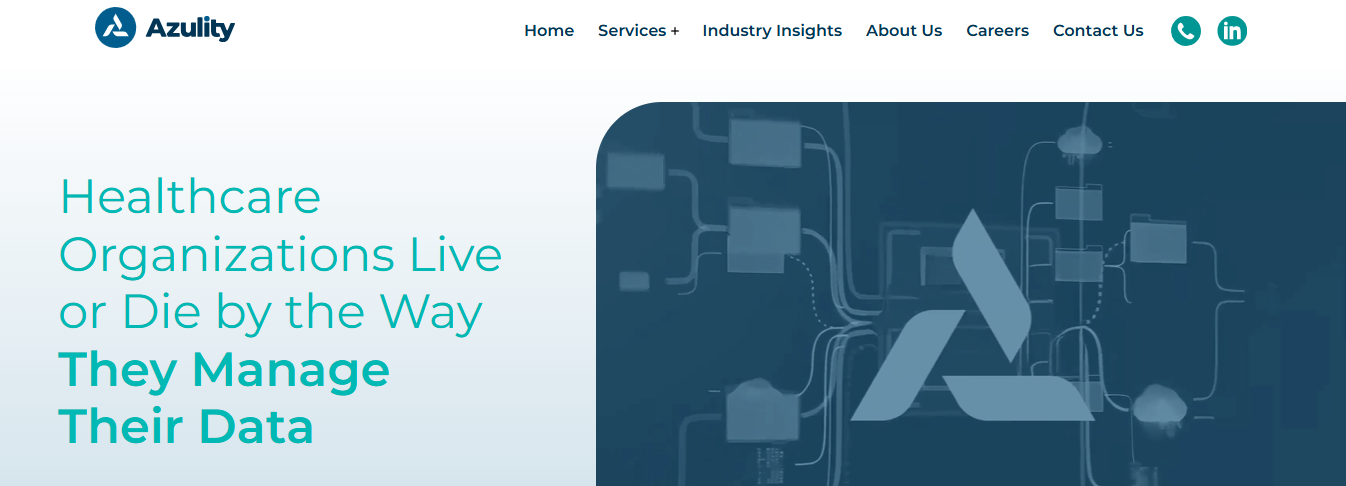Consider you’re in a hospital waiting room. You are anxious about your health, and the minutes feel like hours. You overhear a conversation between two nurses. One of them says, “We’re so short-staffed that we’re having to cut back on patient care for the time being,” and your heart sinks. Staffing issues in healthcare can happen to any facility, but they are especially problematic in the midst of a crisis.
Resource allocation in healthcare, including efficiently staffing your facility, can help you recover from challenging situations and provide better care moving forward. In this guide, we’ll explore how effective resource allocation can ease staffing issues in healthcare and offer actionable insights to help your facility regain stability and empower your healthcare services with credentialing.
One way to improve resource allocation and ease staffing issues in healthcare is to implement Azulity’s provider credentialing services. With Azulity’s solution, you can streamline the credentialing process to limit disruptions to patient care and help your facility get back to normal after a crisis.
Importance of Resource Allocation in Healthcare


Resource allocation involves systematically selecting and assigning existing resources to a task or project to support business objectives. In accounting, allocation deals with assigning people and their skills to projects, also known as engagements. The essence of optimal resource allocation for any accountancy firm is matching the right people with the right experience, qualifications, and skills with the right client and task at the right time.
Effective allocation should:
- Ensure work is divided evenly among all resources to prevent staff burnout
- Empower teams by ensuring resources have the skills, knowledge, and training necessary to complete allocated work
- Ensure engagement performance is optimised by matching the right resources to the right task at the right time.
Poor resource allocation will impact overall performance in project delivery. Lacking the right skills or knowledge can result in loss of efficiency, time, confidence, and motivation.
An optimal allocation process in accounting is key to empowering teams, preventing burnout, and ensuring engagement performance. Allocation is not only an essential management process but also a critical lever for growth and success.
Consistently allocating the right resources to the right tasks at the right time is crucial for successful and profitable client engagements. When a firm allocates its resources, it matches the dedicated resources to achieve client and business objectives.
Key Aspects of Healthcare Resource Allocation


High-Level Documents and General Policies of the Health System
These overarching policies and strategic documents guide the direction and priorities of resource allocation. Resource allocation in healthcare is influenced by high-level documents and general policies of the health system, which guide the direction and priorities of resource allocation.
For example, the World Health Organization provides guidelines on allocating health resources during a crisis, such as an outbreak or natural disaster. The Centers for Disease Control and Prevention also publishes materials on health resource allocation to address the burden of specific diseases and public health challenges.
Burden of Diseases
The prevalence and impact of various diseases determine where resources are most needed to address public health challenges effectively. The burden of disease describes the effects of a particular health problem on a given population. Specifically, this metric considers both the disease’s prevalence and how it affects quality of life and life expectancy.
The higher the disease burden, the more healthcare resources it will require. As such, a population’s disease burden can help inform forecasts that predict what health problems will need the most attention in the future and where to allocate resources now to mitigate the impact of diseases on healthcare systems and affected populations.
Number of Population Covered
The size of the population served influences the distribution of resources to ensure adequate healthcare delivery. The number of people covered by a healthcare system or plan will impact how resources are allocated.
For example, a sudden influx of patients due to a natural disaster or disease outbreak can strain existing resources. In this case, health systems may need to quickly draw from external sources to address the needs of the patient population.
As more patients are treated, they may require specialized care for various conditions. In such situations, existing healthcare facilities may be ill-equipped to manage the needs of the new patient population, and resource allocation will need to shift to account for these challenges.
Infrastructure of Covered Regions
The existing healthcare facilities and infrastructure in different regions affect the feasibility and efficiency of resource utilization.
The healthcare infrastructure of a given region can also impact how resources are allocated both before and after a crisis.
For example, if a natural disaster strikes a community, existing facilities may be damaged and need repair. In addition, the local population may have specific health needs that differ from the area’s typical disease burden. Before resources can be allocated, it is vital to assess the damage to healthcare facilities and understand the local population’s health needs to ensure adequate care.
Population Health Needs
The specific health requirements and priorities of the population guide targeted resource allocation. A population’s particular health needs will ultimately dictate how resources are allocated in a given situation.
For example, if a community has been impacted by a hurricane, health resources will need to be directed toward addressing storm-related injuries and trauma and treating pre-existing conditions that may worsen due to the disaster. Public health officials will need to assess the local population to determine existing healthcare challenges quickly, allocating resources to address these needs before moving on to more general health issues.
Influencing Factors
Current Budget
The demands and priorities set by the influencing factors shape the available financial resources. A healthcare system’s current budget will impact how resources are allocated in any given situation.
For example, if a facility is already operating with a deficit, it may struggle to effectively address the sudden influx of patients resulting from a public health crisis. In such situations, existing resources may be exhausted quickly, leading to poorer health outcomes for those affected.
Expected Benefits of People
The anticipated health outcomes and improvements for the population depend on how resources are allocated.
The ultimate goal of resource allocation in healthcare is to improve patient outcomes. As such, stakeholders will allocate resources in a way that will benefit the population’s health promptly.
Expected Benefits of Policymakers
The objectives and goals of policymakers are achieved based on effective resource distribution.
Just as the primary focus of resource allocation is to improve patient outcomes, policymakers also have specific goals they wish to achieve through effective resource distribution.
Financial Returns of the Resource Allocation
The economic efficiency and potential cost savings resulting from strategic resource allocation are contingent on the influencing factors.
Finally, stakeholders will also consider how resource allocation in healthcare can improve the economic efficiency of the system. Strategic allocation can reduce waste and redundant processes, saving money and improving overall financial health.
Azulity specializes in healthcare master data management and provider credentialing services, bringing proven expertise in implementing healthcare data solutions and credentialing across the US. Our comprehensive platform ensures consistent patient, provider, location, and claims data synchronization across all systems and departments.
Key features include: healthcare MDM, provider MDM, reference data management, credentialing, and provider enrollment. We serve healthcare technology leaders – from CIOs and CDOs to VPs of data platforms and credentialing – helping them eliminate the costly problems of fragmented data systems. Book a call to learn more about our healthcare master data management services today!
Related Reading
7 Best Practices for Resource Allocation in Healthcare


1. Use Technology like Azulity ‘


Technology offers innovative solutions to streamline healthcare operations, enabling organizations to respond to challenges more effectively. Azulity specializes in health care master data management and provider credentialing services. The company brings proven expertise in implementing healthcare data solutions and credentialing across the U.S. Their comprehensive platform ensures consistent synchronization of patient, provider, location, and claims data across all systems and departments.
Key features include healthcare MDM, provider MDM, reference data management, credentialing, and provider enrollment. Azulity serves healthcare technology leaders—from CIOs and CDOs to VPs of data platforms and credentialing—helping them eliminate the costly problems of fragmented data systems.
2. Implement Efficient Resource Management Practices
Efficient resource management practices can help healthcare organizations allocate resources more effectively. Cost-benefit analysis can evaluate the potential benefits of interventions relative to their costs to prioritize high-impact areas. Practitioners can also focus on areas that offer the most significant health benefits per unit of resource invested.
3. Utilize Predictive Analytics
Predictive analytics play an essential role in resource allocation. Data-driven tools can help healthcare organizations forecast demand, enabling proactive resource distribution and preventing shortages.
4. Adopt Equity-Based Models
Equity-based models help ensure fair resource distribution by prioritizing underserved communities. These models also encourage healthcare organizations to review allocation practices regularly to address health disparities.
5. Engage Stakeholders Transparently
Resource allocation can significantly impact diverse stakeholder groups. Engaging these stakeholders in decision-making can help organizations align interests and facilitate effective resource allocation. Using clear criteria throughout the process promotes transparency and trust.
6. Establish Ethical Guidelines
Clear ethical frameworks guide decision-making for allocating scarce resources during crises. These structures should involve ethics committees to provide guidance and oversight.
7. Leverage Mathematical Optimization
Advanced mathematical algorithms can provide evidence-based recommendations for prioritizing health spending, considering policy objectives and system constraints.
Challenges of Resource Allocation in Healthcare


1. The Alarming Shortage of Skilled Medical Professionals
The healthcare sector is facing a severe shortage of skilled professionals. This shortage has various reasons, including high turnover rates, inequitable workforce distribution, and a lack of quality education providers. Even the high fees for medical courses are a significant roadblock for several individuals wanting to build a medical career.
Lack of medical staff means that there are a limited number of professionals to manage the healthcare needs of patients. Overtime and burnouts are very common in the medical industry, and this significantly impacts the quality of healthcare received by the patients.
2. Misallocation of Resources
When resources are available and allocated, they are often not optimized. Medical professionals with higher skill sets are usually required to work on low-priority cases, and those with lower skills and experience are made to work on more critical projects.
As long as the hiring and allocations meet the minimum requirements of a healthcare facility, this non-optimal resource allocation in healthcare resources is very common. An important reason for this problem is the unsteady nature of the healthcare industry. Unlike other industries, you cannot estimate resource allocation in a medical facility.
If the resources are efficiently handled after considering red flags and unexpected emergencies, their usage can be optimized. A healthcare resources management tool like eResource Scheduler can make the resource allocation more transparent and efficient.
3. Underinvestment in Staff Training
Medical technologies are advancing rapidly. As a result, medical professionals are regularly required to upgrade themselves with newer skills through short courses and workshops. However, many healthcare facilities do not encourage their medical staff enough for such upgrades.
Also, some facilities do not sponsor such upgrades due to which the medical professionals are required to manage the entire expenses themselves. This apathetic attitude discourages them and impacts the overall growth of the healthcare industry.
4. Poor Documentation of Resource Allocation
When allocating healthcare resources or resources in any industry, for that matter, it is essential to document the allocation and utilization properly. Many medical facilities rely on traditional manual systems, where records are updated in lengthy spreadsheets highly prone to errors. Poor documentation can impact the resource allocation strategy’s effectiveness and make it very difficult for a facility to respond to an emergency. In emergencies, the resources are allocated occasionally without proper planning or documentation.
This brings us back to the importance of using reliable resource allocation software. Such solutions can increase transparency in healthcare resource allocation and help maintain detailed and accurate documentation.
5. Ineffective Reallocation of Resources
As a staff manager working at a healthcare facility, one of your most important responsibilities is to try to avoid employee burnout as much as possible. This cannot be eliminated, so do your best to keep it to a minimum. Burnouts not only affect the work quality of the employees but also make them unhappy with the job.
So, when you see someone on your team overworked, adjust to manage the workload. Resource leveling is a popular technique of resource allocation in healthcare. In this technique, activities are merged or divided based on the availability of resources to split the work.
6. Micro-Managing Resources
Healthcare is a field where everything should be double-checked for the safety of the patients. Employees don’t like to be micromanaged. No one would appreciate staffing or a project manager who wants to manage every small aspect of their job.
Delegate tasks and allow medical professionals to handle things on their own. This way, the staff will not only feel more responsible but also improve their confidence. If a particular employee doesn’t seem fit for a specific task, allow him/her to take additional training workshops.
Related Reading
- Employee Retention in Healthcare
- Recruitment Challenges in Healthcare Industry
- Healthcare Data Analyst Requirements
Book a Call to Learn More About Our Provider Credentialing Services
Azulity specializes in healthcare master data management and provider credentialing services, bringing proven expertise in implementing healthcare data solutions and credentialing across the US. Our comprehensive platform ensures consistent patient, provider, location, and claims data synchronization across all systems and departments.
Key features include: healthcare MDM, provider MDM, reference data management, credentialing, and provider enrollment. We serve healthcare technology leaders – from CIOs and CDOs to VPs of data platforms and credentialing – helping them eliminate the costly problems of fragmented data systems. Book a call to learn more about our healthcare master data management services today!
